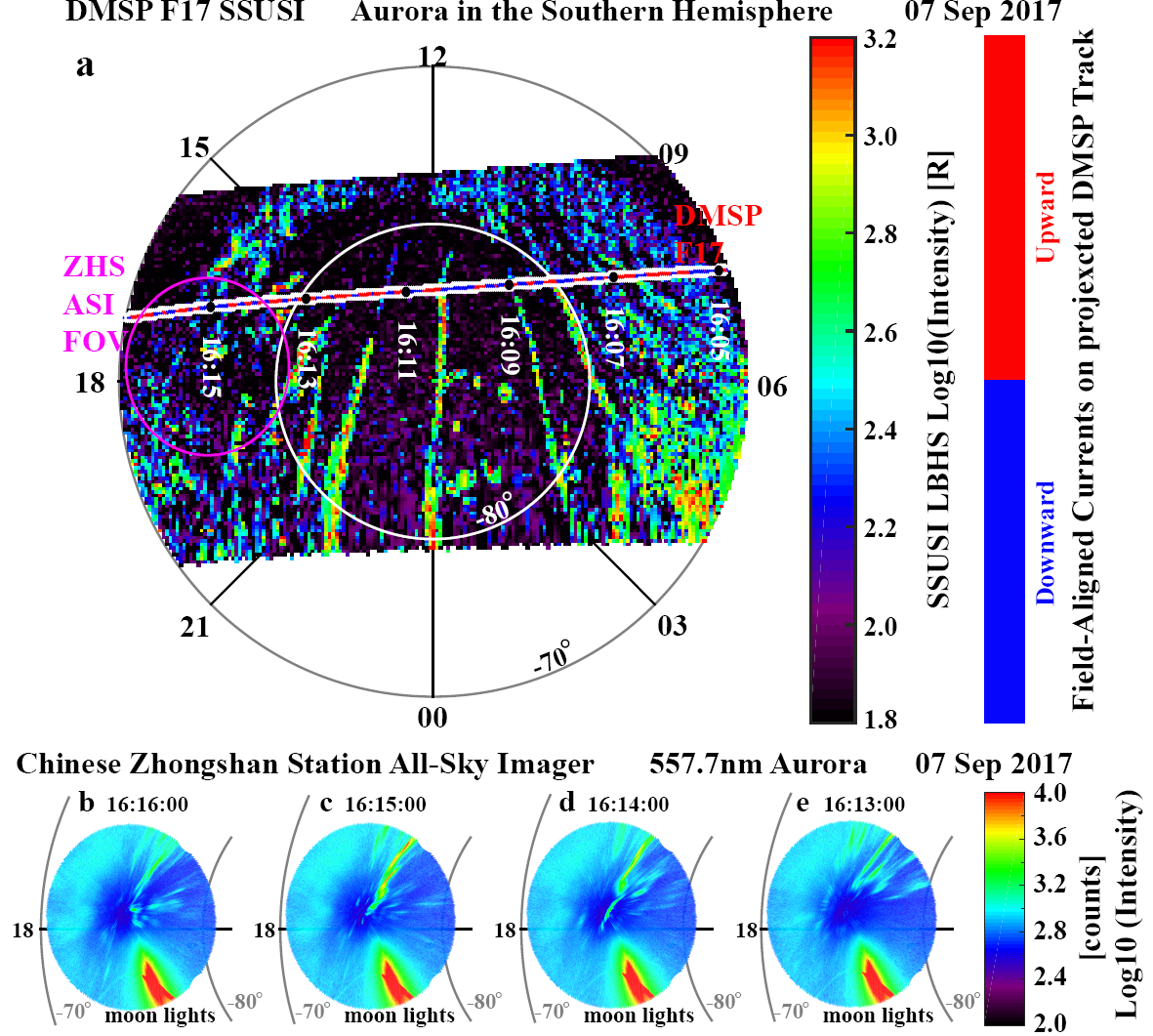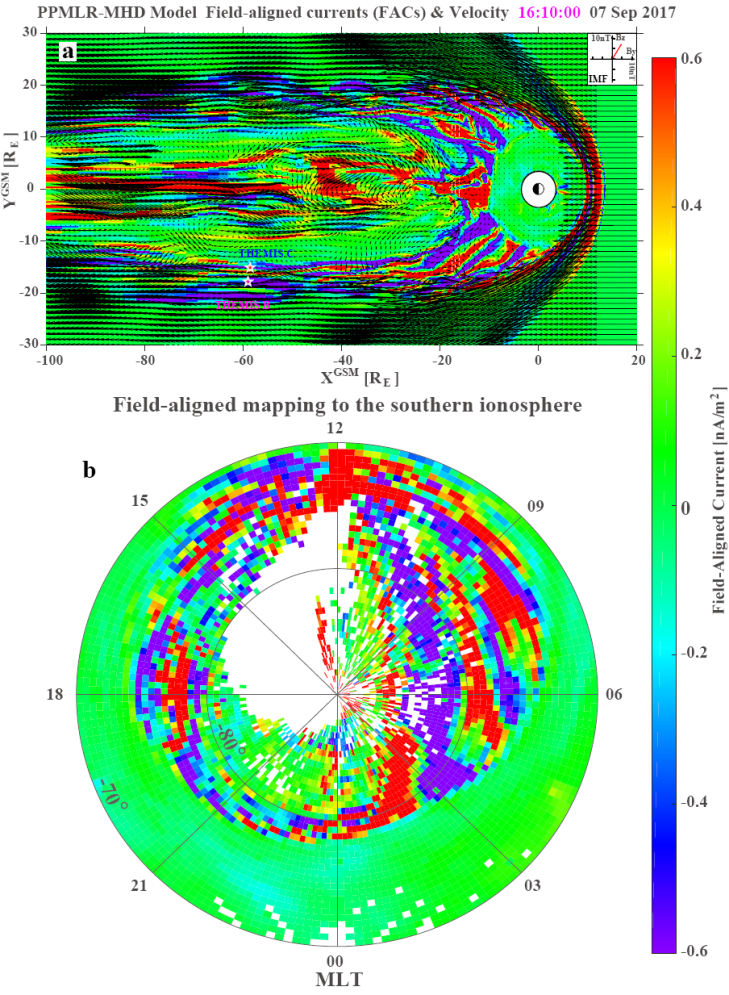Recently, Professor Zhang Qinghe’s research group, from School of Space Science and Physics, Institute of Space Sciences, has published their new progress entitled “Multiple transpolar auroral arcs reveal insight about coupling processes in the Earth’s magnetotail” in Proceedings of the National Academy of Sciences of the United States of America (PNAS). By using the comprehensive observationsin the ionosphere and magnetotail as well as a 3-D magnetosphere modeling, the formation mechanism of multiple transpolar auroral arc (TPA) has been investigated for the first time. Professor Zhang Qinghe is the first author and corresponding author, Professor Zhang Yongliang from the Johns Hopkins University Applied Physics Laboratory State Key, and Professor Wang Chi from Center for Space Science and Applied Research,Chinese Academy of Sciences, make great contributions to this work.

Figure 1. Multiple auroral arcs photo taken at the Chinese Antarctic Zhongshan station.
Colorful and dynamic aurora has attracted human’s attention since the dawn of time. However, mystery remains in understanding a distinct class of aurora,called transpolar auroral arc (TPA)that stretch almost entirely across the polar cap and connect the dayside and nightside auroral oval(in some cases called “theta” aurora), which appears in the extremely high latitude ionosphere of the Earth when interplanetary magnetic field (IMF) is northward that occurs nearly half of the time.The formation and evolution of TPA offers clues about processes transferring energy and momentum from the solar wind to the magnetosphere and ionosphere during a northward IMF. The associated auroral particle precipitation can cause the ionospheric scintillations, which will affect the communications and navigations in the polar regions.
However, previous theories are unable to explain why multiple TPAs often occur, and the formation mechanism of multiple TPAs remain poorly understood and controversial. By using the comprehensive observations from ionospheric DMSP satellite, magnetospheric THEMIS satellite, all sky imager in Chinese Zhongshan station, and a high resolution 3D global MHD simulation (PPMLR-HMD), Professor Zhang Qing-He’s group trying to investigate the unsolved scientific problem.
The research group report a new mechanism identified from multiple-instrument observations of unusually bright, multiple TPAs and simulations from PPMLR-HMD model. On 7 September 2017, long-lasting, relatively stable northward IMF conditions (IMF Bz > 0 for more than 8 hours) occurred with comparable dawn–dusk components (IMF By) and roughly stable solar wind andquiet geomagnetic conditions. At least six bright TPAs are shown in the polar cap (several of the TPAs were brighter than the main auroral oval with brighter spots within them). The observations and simulations show an excellent agreement and reveal that these multiple TPAs are generated by precipitating energetic magnetospheric electrons within field-aligned current (FAC) sheets. These FAC sheets are generated by multiple flow shear sheets in both the magnetospheric boundary produced by Kelvin-Helmholtz instability between super-sonic solar wind flow and magnetosphere plasma, and the plasma sheet. These flow shears directly lead to multiple FAC sheets and field-aligned acceleration of electrons which create multiple cusp-aligned auroral arcs both in the polar cap and auroral oval. This is a general mechanism for the formation of auroral arcs. The reviewers said:” ……the paper resolves some apparent difficulties that have faced the interpretation of TPAs. I would therefore consider this paper to offer more than an incremental step in our understanding of TPAs.”

Figure 2. Aurora and in-situ FAC observations in the Southern Hemisphere. (a) Aurora observed by the SSUSI on board the DMSP F17 satellite, FACs shown in red and blue along the satellite track; (b–e)sequence of 557.7-nm aurora images from the all-sky imager at the Zhongshan Station.

Figure 3. The FACs and plasma velocity vectors in the X-Y plane in GSM coordinates simulated by the PPMLR-MHD code. (a) The 2D distribution in the equatorial plane; (b) field-aligned mapping from the equatorial plane to the ionosphere in the Southern Hemisphere.
This work was supported by the Chinese Meridian Project, the National Natural Science Foundation, the Specialized Research Fund for State Key Laboratories of China and National Key Laboratory of Electromagnetic Environment and the International Space Science Institute in Beijing. In recent years, Professor Zhang Qing-He’s group have been focused on the Research of ionosphere-magnetosphere coupling and the associated space weather effects, and have made a series of progresses, such as ionospheric polar cap patches as a trace of the large-scale Dungey convection cycle. Relevant works have been published in Science as a highlight paper [Science, 339, 1597-1600 (2013)] and in Journal Geophysics Researches: Space Physics as a cover letter paper [JGR, 121, 9063–9074 (2016)].
The link of this paper:
https://www.pnas.org/content/early/2020/06/23/2000614117
Written by:Xing Zanyang
Edited by:Che Huiqing